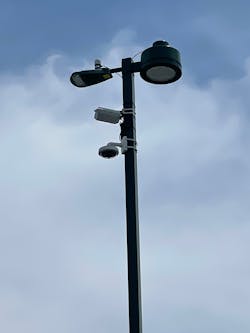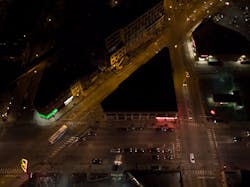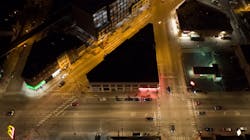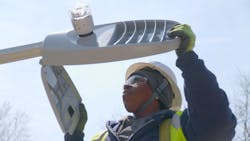PROJECTS | Smart lighting technology enriches community experience and safety
Streetlights reveal the urban form by night and bring a city’s skyline to life. Essential for safety and wayfinding, these fixtures consume a considerable amount of energy — they often are cities’ greatest or second greatest energy load, accounting for 25% to 50% of municipal energy bills. As a result, cities and towns nationwide have committed to retrofitting streetlights and other exterior fixtures with LEDs equipped with advanced controls, allowing them to monitor for maintenance, energy usage, and output.
Cities’ go-to streetlamps have long been high-pressure sodium (HPS) or metal halide, but LEDs present numerous benefits over these conventional lamp types. Not only do LED fixtures consume up to 75% less energy than HPS fixtures, but they also lower operation and maintenance costs.
LEDs’ wide range of possible correlated color temperatures and output levels allow the lighting grid to adapt to zoning regulations or accommodate each city’s preferences. Quality illumination and color rendering enhance visibility for motorists, cyclists, and pedestrians and improve public safety. High-quality light combined with camera systems can also help with police surveillance.
Chicago and Mesa, Ariz., are two cities that recently made the move to smart LED streetlights, attaining the illumination and energy benefits, as well as an improved community experience.
Connectivity in a desert community
After moving toward becoming a smart city for the past several years, the city of Mesa, Ariz., population 500,000, engaged Signify to conduct a lighting retrofit of its existing streetlight infrastructure and transform it into a platform for broadband connectivity. Utilizing Signify’s BrightSites technology, the city replaced existing light fixtures to support public Wi-Fi and CCTV cameras.
BrightSites removes the need to dig up roads and sidewalks to lay new fiber; instead, each streetlight functions as a communications node in a wireless mesh network that deploys virtual fiber connectivity. System components include a digital smart hub, broadband luminaires, and smart poles. Smart poles provide broadband connectivity and a 4G/5G and Wi-Fi infrastructure, serving as a platform for various IoT applications, including cameras for certain streetlights, all within a cleanly packaged aesthetic. Each pole was replaced from the ground up, including the streetlight heads. Interact City Nodes — luminaire-based control devices that connect streetlights to the Interact City LMS using cellular technology — manage, monitor, and control each streetlight individually.
The Mesa police department has a real-time crime center that pulls together video feeds for “eyes on the scene” during a 911 call. This involves ongoing collaboration with the community to determine where citizens want enhanced safety. Cameras are also utilized in parking lots and along streets with parking to analyze congestion, which is then pushed to an app available to community members who might use it to determine the best place to park when attending an event, for example.
Community engagement has been key to the success of Mesa’s smart lighting project from the outset. According to Harry Meier, the city’s deputy CIO for Innovation, city officials conducted public town halls in many neighborhoods to share the benefits of converting to LEDs and to listen to residents’ preferences. This led to the development of a city master plan defining four zones with unique needs in terms of color temperature, brightness, and dimming capabilities based on primary use (see sidebar "City of Mesa master plan designates four lighting zones" below).
For instance, the downtown zone requires bright lights with a cool, daylight-like color temperature to improve public safety and highlight local businesses by making signage pop. On the other hand, rural and semi-rural residential areas call for dimmer and warmer lighting.
All of the approximately 42,000 streetlights citywide are dark-sky compliant and avoid casting unnecessary light upward into the night sky.
The public response so far has been overwhelmingly positive, thanks in part to the city’s willingness to make adjustments as requested; for example, the city installed shielding on several fixtures to avoid creating glare inside a residence. “Little touches like that really speak to the people in the neighborhoods that we’re listening,” Meier said. “To have a crew come out and adjust just that light in front of your house really connects with a resident and says that the city is listening to them.”
A proposed next step for Mesa is installing kiosks on street corners that provide wayfinding, public safety information, and a local event calendar. These kiosks will serve as a new platform for the city to connect with its community members. All this is possible without running fiber because the kiosks can communicate wirelessly via the broadband luminaires.
“Cities see the value of LED lighting and controls because of the potential for energy savings, sustainability benefits, better service to the community, and significant maintenance cost savings,” said Scott McCarley, director of marketing, public systems and services for Signify. “But the opportunity is to leverage that momentum to deliver more technology, and this is where Mesa is a wonderful example of a city that has demonstrated success.”
City of Mesa master plan designates four lighting zones
City officials classified all Mesa public streets into four distinct zones, determined by low-roadway activity periods for planning dimming schedules.
LZ4: Downtown
High Pedestrian Activity/Downtown Areas/Regional Commercial — Areas with a high level of nighttime vehicular and pedestrian activity. Light levels meet RP-8 recommendations for all roadway classifications. After curfew, lighting may be reduced in some areas as activity levels decline.
LZ3: Standard
Ordinary Roadways (includes most city streets) — Areas with low to medium levels of nighttime vehicular and pedestrian activity. After curfew, lighting may be reduced in some areas as activity levels decline.
LZ2: Reduced
Special Variances for Lower Levels — Areas with low levels of pedestrian activity and special areas that have requested a reduced light level (as approved per development agreement). Light levels meet RP-8 recommendations for collector and arterial roadway classifications. Lower light levels on residential streets. After curfew, lighting may be reduced as activity levels decline.
LZ1: Rural
Outlying Residential and Low density 2.5 DU per Acre or Less — Areas in the outlying districts within the City of Mesa limits that include Desert Uplands, Lehi area, and zoning with 2.5 DU per acre or less. Light levels meet RP-8 recommendations for arterial roadway classification. Lower light levels on collector and residential streets. After curfew, lighting may be reduced as activity levels decline.
Chicago targets energy savings and public safety
Chicago in collaboration with Ameresco, a cleantech integrator and renewable energy asset developer, owner, and operator, has replaced 85% of its conventional streetlights with smart city technology to reduce energy consumption and improve public safety.
Ameresco kicked off the project by surveying the city’s 300,000-plus existing lights to evaluate the state of the network. The team pinpointed which equipment required repair or replacement, tracked GIS asset locations, and established a baseline to track progress.
In addition to new lighting hardware, the project leveraged Itron’s IPv6 platform to support maintenance of the new fixtures and nodes. Real-time outage alerts are provided through the lighting management system (LMS) which integrates with the city’s 311 system and allows for remote management and monitoring of individual fixtures by city employees. This reduces downtime as maintenance calls are more efficiently managed.
Ameresco executive vice president Lou Maltezos and vice president Steve Taggart noted that resident involvement was “a priority area.” Ultimately, they said, “this project was being completed by and for the people of Chicago.” Chicago Department of Transportation (CDOT) conducted field tests in different neighborhoods, testing light levels and color temperatures with residents’ feedback, landing at 3000K.
The quality of light produced by the new LEDs produces clearer images from city video cameras that aid in Chicago’s police efforts. The team prioritized installations in historically underserved locations to “increase neighborhood security and equitable access to clean technology.”
The project contracted Lyons View Manufacturing, a local minority-owned business, to assemble and install new GE cobrahead fixtures and integrate ornamental LED replacement kits, fostering additional community pride.
All told, the $160 million project replaced more than 270,000 existing light fixtures with LEDs. This resulted in a 50% reduction in energy consumption, or more than $10 million in annual savings for the city and its taxpayers. In addition, the city is eligible for approximately $35 million in energy efficiency rebates.
“This project provides clearer, more reliable, energy-efficient lighting in every Chicago neighborhood with an expected savings of $100 million over the next 10 years,” said CDOT commissioner Gia Biagi. Ameresco’s Maltezos and Taggart said the significant reduction in carbon footprint with the smart LED system also aids in meeting the state of Illinois’ 2050 energy objectives.
PRODUCT DETAILS
Lighting fixtures from General Electric, Signify, LeoTek, Vega, Acuity Brands, and Kenall
In the works: Boston and Philadelphia
The LED retrofit efforts of Chicago and Mesa serve as excellent case studies as other cities undertake their own projects.
In the Northeast, two cities are in the early stages of converting their streetlights to smart city systems. As part of the third phase of Renew Boston Trust, which aims to support carbon neutrality goals, Boston has engaged Ameresco to audit and retrofit 80,000 streetlights and other exterior fixtures with LEDs. Based on the initial audit, the city will implement its plan in stages over several years.
Likewise, the Philly Streetlight Improvement Project aims to convert 120,000 HPS streetlights into LEDs controlled by a new LMS. The move will save the city $5.4 million annually, reducing carbon emissions by 15,000 metric tons per year.
Looking at a city as a combination of building blocks rather than as a singular whole and formulating approaches based on specific needs of various neighborhoods and zones have proven to be keys to success.
MURRYE BERNARD, R.A., LEED AP, is an architect, writer, and editor whose work has appeared in many architecture and design publications, including Architect, Architectural Record, Architectural Lighting, and Architectural SSL.
Follow our LinkedIn page for our latest news updates, contributed articles, and commentary, and our Facebook page for events announcements and more. You can also find us on Twitter.










